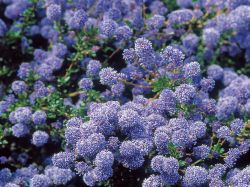Plant
Doctor Archive
Coastal
colour
  IN
Issue 129 of Weekend Gardener, mention was made of Ceanothus
papillosus being "tough and able to withstand drought, trimming
and exposed coastal conditions". IN
Issue 129 of Weekend Gardener, mention was made of Ceanothus
papillosus being "tough and able to withstand drought, trimming
and exposed coastal conditions".
Does that mean the bush
will cope with salt spray on its branches? I find that frequently
plants are called coastal but when the harsh southerlies come along,
it's farewell to the plant.
Secondly, I've tried
to buy Ceanothus papillosus at two of Wellington's larger
plant shops. One tried to get it for me but neither could oblige.
Do you know where I could purchase a plant?
 THE
form of Ceanothus papillosus most widely available here is
commonly known as Ceanothus 'Roweanus'. Most garden centres
would have it by the latter name or be able to get it for you, particularly
branches of California Garden Centre, Palmers Gardenworld or Mitre
10. THE
form of Ceanothus papillosus most widely available here is
commonly known as Ceanothus 'Roweanus'. Most garden centres
would have it by the latter name or be able to get it for you, particularly
branches of California Garden Centre, Palmers Gardenworld or Mitre
10.
Wellington's salt-laden
wind can be particularly harsh - I've even seen the new growth of
so-called hardy natives like pohutukawa and broadleaf (Griselinia
littoralis) burnt off during a severe southerly!
So, while ceanothus can
reasonably be expected to withstand coastal conditions, I'd recommend
you plant it where it's not exposed to wind coming directly from
the sea, especially if your garden is within 100m or so of the coast.
If closer, a tall fence
or hedge of tough plants such as taupata (Coprosma repens),
Chatham Island akeake (Olearia traversii) or karo (Pittosporum
crassifolium) should provide enough shelter for this delightful
plant, which is one of the best blue flowering shrubs available
- even though the display only lasts a few weeks in spring.
Weekend
Gardener, Issue 135, 2003, Page 27
Reproduced with permission from the former Weekend Gardener magazine. The views expressed here are not necessarily those of the RNZIH.
|
 |
 |
|